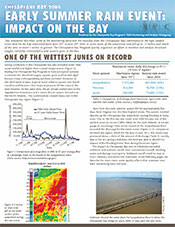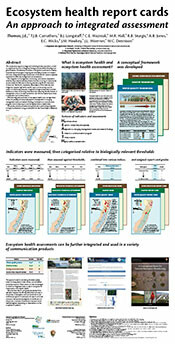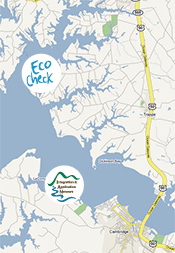Early summer rain event newsletter
 EcoCheck (UMCES-NOAA Partnership) in collaboration with the Chesapeake Bay Program has produced a newsletter, Early summer rain event: impact on the Bay, describing some of the monitoring data and the response from the Chesapeake Bay community to the high rainfall event that hit the Bay watershed from June 24th to June 28th 2006. In some areas of the watershed, up to 15 inches of rain fell, and much of the area received 7 inches or more. The Chesapeake Bay Program quickly organized an effort to monitor and analyze dissolved oxygen, turbidity, chlorophyll a and aquatic grass in the Bay.
EcoCheck (UMCES-NOAA Partnership) in collaboration with the Chesapeake Bay Program has produced a newsletter, Early summer rain event: impact on the Bay, describing some of the monitoring data and the response from the Chesapeake Bay community to the high rainfall event that hit the Bay watershed from June 24th to June 28th 2006. In some areas of the watershed, up to 15 inches of rain fell, and much of the area received 7 inches or more. The Chesapeake Bay Program quickly organized an effort to monitor and analyze dissolved oxygen, turbidity, chlorophyll a and aquatic grass in the Bay.
Ecosystem health report cards: An approach to integrated assessment
 Integrated ecological assessment of the world’s coastal ecosystems is essential for effective management and remediation. The integration of management, monitoring, and science is required to solve the major environmental problems that are occurring in coastal zones around the world. Effective monitoring requires a significant investment of resources. Field work is expensive, data analysis is time-intensive, data integration requires high level scientific input, and recurring costs are subject to inflationary pressures. Integrated ecological assessment provides feedback on these monitoring investments by measuring the effectiveness of management actions. Societal momentum can then be created by successes in assessment and communication. This poster presents processes and approaches to performing integrated ecological assessments, using an example from the Coastal Bays of Maryland.
Integrated ecological assessment of the world’s coastal ecosystems is essential for effective management and remediation. The integration of management, monitoring, and science is required to solve the major environmental problems that are occurring in coastal zones around the world. Effective monitoring requires a significant investment of resources. Field work is expensive, data analysis is time-intensive, data integration requires high level scientific input, and recurring costs are subject to inflationary pressures. Integrated ecological assessment provides feedback on these monitoring investments by measuring the effectiveness of management actions. Societal momentum can then be created by successes in assessment and communication. This poster presents processes and approaches to performing integrated ecological assessments, using an example from the Coastal Bays of Maryland.
Morro Bay Workshops
 Staff from the Integration and Application Network participated in a series of workshops in Morro Bay, California. This was the first stage of a synthesis project with the Packard Foundation, working in three of their regional initiative sites. The key aim was to synthesize key features, current knowledge and management priorities within Morro Bay into a series of conceptual diagrams. The first two days were spent obtaining the information from scientists and managers as well as field trips to take resource photos of the mudflats and rocky shoreline. The last evening was an open meeting with members of the public where the diagrams were presented for input and feedback. These resources will now be used in a series of communications products including a newsletter, web site and presentations.
Staff from the Integration and Application Network participated in a series of workshops in Morro Bay, California. This was the first stage of a synthesis project with the Packard Foundation, working in three of their regional initiative sites. The key aim was to synthesize key features, current knowledge and management priorities within Morro Bay into a series of conceptual diagrams. The first two days were spent obtaining the information from scientists and managers as well as field trips to take resource photos of the mudflats and rocky shoreline. The last evening was an open meeting with members of the public where the diagrams were presented for input and feedback. These resources will now be used in a series of communications products including a newsletter, web site and presentations.
Job Vacancies
 The University of Maryland Center for Environmental Sciences (UMCES) Integration and Application Network is currently accepting applications for two positions: Science Communicator with a background in estuarine science together with strong written and oral communication skills. The successful candidate will work in partnership with the NOAA Chesapeake Bay Office staff through the EcoCheck project at the Cooperative Oxford Laboratory in Oxford, Maryland; Intern to assist with the production of visual elements and science communication products. It is expected that the successful applicant will have excellent computer skills, a background in science and a desire to be part of a dynamic team interested in solving not just studying environmental challenges. For further information, please visit the UMCES employment page.
The University of Maryland Center for Environmental Sciences (UMCES) Integration and Application Network is currently accepting applications for two positions: Science Communicator with a background in estuarine science together with strong written and oral communication skills. The successful candidate will work in partnership with the NOAA Chesapeake Bay Office staff through the EcoCheck project at the Cooperative Oxford Laboratory in Oxford, Maryland; Intern to assist with the production of visual elements and science communication products. It is expected that the successful applicant will have excellent computer skills, a background in science and a desire to be part of a dynamic team interested in solving not just studying environmental challenges. For further information, please visit the UMCES employment page.